
Maserati S.p.A. is an Italian luxury vehicle manufacturer. Established on 1 December 1914 in Bologna, Italy, the company's headquarters are now in Modena, and its emblem is a trident. The company has been owned by Stellantis since 2021. Maserati was initially associated with Ferrari. In May 2014, due to ambitious plans and product launches, Maserati sold a record of over 3,000 cars in one month. This caused them to increase production of the Quattroporte and Ghibli models. In addition to the Ghibli and Quattroporte, Maserati offers the Maserati GranTurismo and two SUV models, the Maserati Levante and the Maserati Grecale. Maserati has placed a yearly production output cap at 75,000 vehicles globally.

The Citroën SM is a high-performance coupé produced by the French manufacturer Citroën from 1970 to 1975. The SM placed third in the 1971 European Car of the Year contest, trailing its stablemate Citroën GS, and won the 1972 Motor Trend Car of the Year award in the U.S.

The Citroën DS is a front mid-engined, front-wheel drive executive car manufactured and marketed by Citroën from 1955 to 1975, in fastback/sedan, wagon/estate, and convertible body configurations, across three series of one generation.

The Fiat X1/9 is an Italian two-seater mid-engined sports car designed by Bertone and manufactured by Fiat from 1972–1982 and subsequently by Gruppo Bertone from 1982–1989.

The Citroën CX is a large, front-engined, front-wheel-drive executive car/luxury car manufactured and marketed by Citroën from 1974 to 1991. Production models were either a standard wheelbase or a stretched, more luxurious, four-door fastback saloon, as well as a station wagon (estate), on the longer wheelbase. The CX is known for its hydropneumatic self-leveling suspension system, and its low 0.36 drag coefficient, normally noted as a vehicle's in French. Restyled as 'CX', the model name underscored this.

Marcello Gandini was an Italian car designer, widely known for his work with the Italian car design house, Bertone, where his work included designing the Alfa Romeo Carabo and Montreal, Lancia Stratos Zero, Maserati Khamsin, Ferrari GT4, Fiat X1/9, and several Lamborghinis, including the Bravo, Miura, Marzal, Espada, Urraco, and Countach. Gandini himself said his design interests prioritised vehicle architecture, construction, assembly, and mechanisms over styling.

Hydropneumatic suspension is a type of motor vehicle suspension system, designed by Paul Magès, invented by Citroën, and fitted to Citroën cars, as well as being used under licence by other car manufacturers. Similar systems are also widely used on modern tanks and other large military vehicles. The suspension was referred to as Suspension oléopneumatique in early literature, pointing to oil and air as its main components.
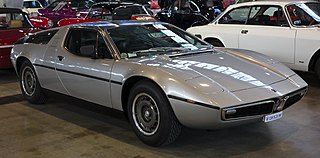
The Maserati Bora is a two-seat, rear mid-engine, rear-wheel drive sports car and grand tourer, manufactured by Maserati from 1971 to 1978. In common with other Maserati cars of the era, it is named after a wind, Bora being the wind of Trieste. The Bora was the company's first mid-engined street car and ended Maserati's reputation for producing fast but technologically out of date cars, also being the first Maserati with four wheel independent suspension. In contrast, competitor Lamborghini had first used full independent suspension in 1964. The Bora was the second-most expensive car of the 1970s following Lamborghini Countach.
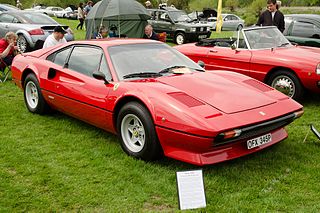
The Ferrari 308 GTB berlinetta and targa-topped 308 GTS are V8 mid-engined, two-seater sports cars manufactured by the Italian company Ferrari from 1975 until 1985. The 308 replaced the Dino 246 GT and GTS in 1975 and was updated as the 328 GTB/GTS in 1985. The similar 208 GTB and GTS were equipped with a smaller, initially naturally aspirated and later turbocharged, two-litre engine, and were sold mainly in Italy.

The Maserati Quattroporte is a four-door luxury sports sedan produced by Italian automobile manufacturer Maserati. The name translated from Italian means "fourdoors". The car is in its sixth generation, with the first generation introduced in 1963.

Maserati Ghibli is the name of three different cars produced by Italian automobile manufacturer Maserati: the AM115, a V8 grand tourer from 1967 to 1973; the AM336, a V6 twin-turbocharged coupé from 1992 to 1998; and the M157, an executive saloon from 2013 until late 2023.

The Maserati Shamal is a two-door grand touring coupé produced by Italian automobile manufacturer Maserati from 1990 to 1996. In keeping with an established Maserati tradition, it is named after a wind: shamal, a hot summer wind that blows in large areas of Mesopotamia, particularly in the large plain between the Tigris and Euphrates.

The Lamborghini Espada is a 4-seat grand touring coupé built by Italian car manufacturer Lamborghini between 1968 and 1978.
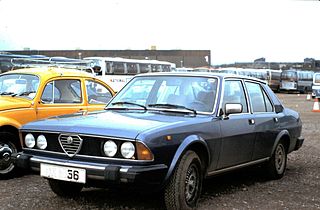
The Alfa Romeo Alfa 6 is an executive car produced by the Italian automaker Alfa Romeo from 1979 to 1986. Its name refers to the six cylinders of the Alfa Romeo V6 engine, which made its first appearance on this car.
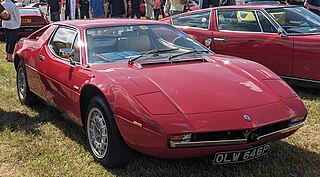
The Maserati Merak is a mid-engined 2+2 sports car produced by Maserati between 1972 and 1983. The Merak was closely related to the Maserati Bora, sharing part of its structure and body panels, but was powered by a 3.0 L V6 in place of the latter's 4.7 L V8. The extra cabin space gained by fitting a smaller and more compact powertrain was used to carve out a second row of seats—suitable for children or very small adults—making the Merak not just a less expensive alternative to the Bora but also a 2+2.

The Maserati Biturbo is a family of executive grand tourers produced by Italian automobile manufacturer Maserati between 1981 and 1994. The original Biturbo was a two-door, four-seater notchback coupé featuring, as the name implies, a two-litre V6 engine with two turbochargers and a luxurious interior.
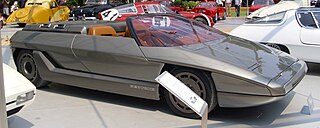
The Lamborghini Athon is a concept car designed by Bertone for Lamborghini.
DIRAVI is the name given by Citroën to its proprietary power steering system, first seen in 1970.

The Maserati Ghibli is an executive car produced by Italian automobile manufacturer Maserati. The car was unveiled to the public at the 2013 Shanghai Motor Show. The Ghibli ended production at the end of 2023.























